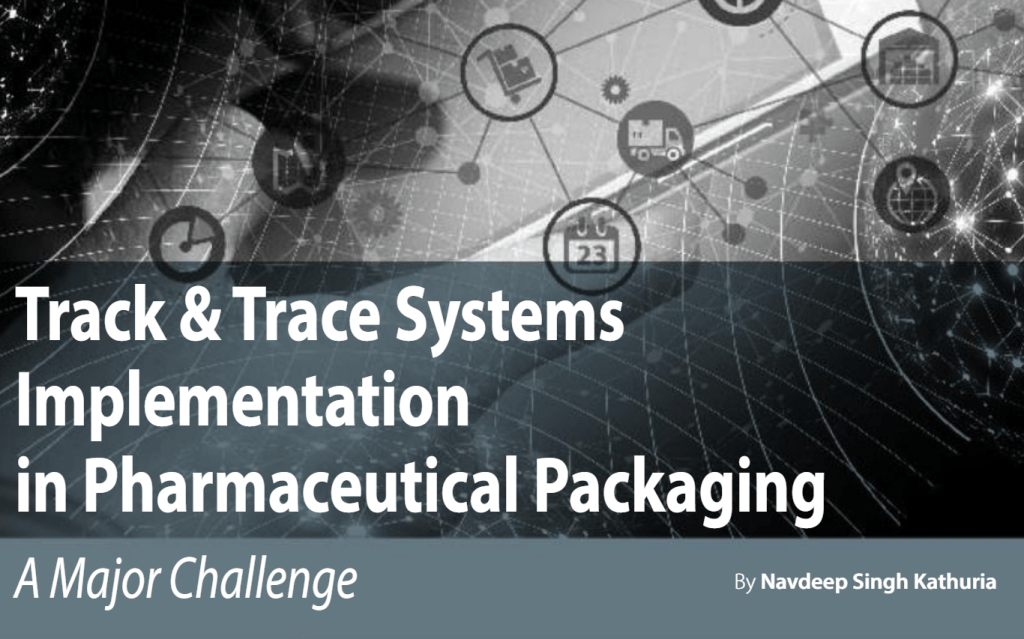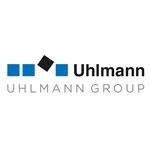
Track & Trace system, nowadays, plays a vital role in preventing counterfeiting during trading, assisting in optimizing monitoring at each level of supply chain and maintaining integrity of the product while dispensing to the customer. However, the entire process is full of challenges, although continuous measures are being taken by both manufacturer and service provider to minimize the errors while transit at various levels of supply chain as well as packing operations and to ensure minimum impact on the productivity.
The pharmaceutical industry around the world has gone through tremendous challenges for the past few years since introduction of Track & Trace systems to comply with the medicinal products verification requirements to prevent counterfeiting and falsification at all levels of product supply chain starting from manufacturer and ending upto the dispensing counter of pharmacist.
To implement the controls, the key importers of medicinal products (USA, UK and Europe) around the globe had formulated the laws and guidelines time to time to ensure correct supply of medicinal products in their respective territories.
A.The Drug Supply Chain Security Act (DSCSA) – United States
To prevent illegal trading, an act (Ordinance H.R. 3204) to supply medicinal products in USA was formulated by experts and was signed by the then President in November 27, 2013, which was defined under two different titles at initial stage.
- Title I : The Compounding Quality Act which contains important provisions relating to the oversight of compounding of human drugs.
- Title II : The Drug Supply Chain Security Act which outlines critical steps to build an electronic, interoperable system to identify and trace prescription drugs as they are distributed in the United States.
On January 01, 2015, the act was amended by the mandatory implementation of product verification as all trading partners were supposed to have ‘Pass and Accept’ Transaction Information (TI), Transaction Statements (TS), and Transaction History (TH) with all sales. (Dispensers shall not accept transaction without TI, TS, TH after 1 July 2015).
The act was further amended on November 2017 to incorporate ‘Unique Product Identifier’ by Supply Chain trading partners and be able to verify the products legitimacy by following dates:
Manufacturers: November 27, 2017
Repackagers: November 27, 2018
Wholesale Distributors: November 27, 2019
Dispensers (Clinics, Retail): November 27, 2020
Unit level Traceability has still been targeted to November 27, 2023, which will enforce the manufacturer to have an aggregation facility on serialized packs as a mandate.
B.Falsified Medicines Directive (EUFMD)
In October 2018, the MHRA reported that since 2015 it had seized almost 10,000 unsafe sexually transmitted infection (STI) and human immuno-deficiency virus (HIV) test kits that could give false negative results leading to an increase in diseases such as chlamydia, syphilis, and gonorrhoea, as well as HIV. Many of the potentially unsafe kits were being sold online. Later that month, in a report on Interpol’s globally co-ordinated Operation Pangea annual initiative that involves 116 countries, the MHRA and its UK partners reported that between 9–17 October 2018, they had seized more than £2 million worth of falsified and un-licensed medicines and medical devices in the UK, including diazepam, modafinil and dermal fillers. Worldwide, the annual Operation Pangea exercise, which was initiated by the MHRA in April 2006, netted potentially dangerous medicines and medical devices worth around £10.9 million and led to the closure of 123 websites, the removal of 535 online adverts.
Looking into the scenario, it was a high time to frame drug regulations to prevent counterfeiting for which ‘EU Falsified Medicines Directive’ (2011/62/EU) (FMD) was adopted in 2011 and introduced new harmonised measures to ensure that medicines in the European Union (EU) are safe and that trade in medicines is properly controlled. The final part of the Directive, the ‘safety features’ Delegated Regulation (EU) 2016/161) comes into force on 9 February 2019.
It is worth noting that according to EU rules, a falsified medication is any medicinal product which has been falsely presented in
- I) Identity of the product, including its packaging, labelling, name, or its’ ingredients list, including excipients, and the strength of those ingredients, or,
- ii) In regard to the country of origin, including the manufacturer, country of manufacture, and the holder of the marketing authorization, as well as the history of medicine’s trading, including the records and documents related to the used channels of distribution.
This definition does not include unintentional quality defects and is without prejudice to infringements of intellectual property rights.
Apart from a unique identifier, the directive recommends implementing a mandatory security measure located on the external package (tamper evident feature) to protect the drug against undesired opening.
The verification process – authentication – will therefore be nothing other than a basic element of pharmaceutical care, optimizing pharmacotherapy and increasing the level of patient safety.
The EU FMD introduced harmonised European measures, which applied from 2013, to help identify and remove falsified medicines from the legal supply chain. The Directive amended the Human Medicines Regulations 2012 to require the introduction of two new safety features:
- i) A unique identifier (UI) in the form of a Data Matrix (2D barcode) and human readable information, comprising: a product code identifying the medicine, pharmaceutical form, strength, pack size and type; a unique randomly generated serial number; batch number; expiry date and
- ii) an anti-tampering device (ATD) on the outer packaging of almost all prescriptions.
At the European level, this is EMVO (European Medicines Verification Organization), and at the national level – NMVO (National Medicines Verification Organization) and their main task was to create data repositories necessary to authenticate individual drug packaging.
C.Challenges faced by pharmaceutical industry during transition phase
If we review the history of implementation of the serialization standards, major key challenges were faced by every manufacturer during transition phase, and it took a plenty of time to come out of the situation with new resolutions, reworks, implications, and strategies:
1.Diverse regulatory norms
Due to different regulatory requirements by regulatory authorities anywhere in the world, they never come to a single platform to draft universal norms. The lack of which complicated the manufacturer to comply the country requirements individually.
Italy already had introduced a tracking system a long back through forming an act (Law 39, Mar 1st. 2002, Art. 40) through generating A.I.C. code of the drug package that is the authorization number issued by the Italian Medicines Agency (AIFA) for commercialization, the label, which to be affixed on secondary package, known as Bollino.
NTIN (National Trade Item number) is still required by Nordic countries having Nordic Article Number, however Global standards (GS1) least recommends it looking into its complexity of identification.
2.Artwork revisions
To comply with the space related constraints on secondary packaging materials to incorporate all details in the form of readable data apart from 2D code data matrix (GTIN, batch numbers, expiry date and unique serial numbers), it became mandatory to revise existing artworks to accommodate all relevant information. Existing stock with old artwork was supposed to be discarded or was packed with tamper evident sticker for European markets. Brexit further added to the complexity.
3.Integration with existing line equipment
Synchronization of existing line components for compatibility with serialization requirements was another challenge due to variety of machine suppliers. Removal of existing equipment and addition of new automated equipment to achieve targets was another factor which added to the company’s cost.
4.Space constraints on packing shop floor
Design of shop floor in packaging area became mandatory to modify to accommodate serialization and aggregation components.
5.Multiple packaging configuration on same packing line
Due to variety of serialization requirements (Print, inspect and aggregate) by different customers for different pack sizes, frequent changeovers and start up time was also increased which had a direct impact on operational efficiency of the plant. Bollino label was a perfect example which was affixed manually, and the process was automated later.
6.IT Infrastructure overhauling
Installation of independent production server and its maintenance, storage of billions of events, data backup, secure data exchange and data protection along with system updating became additional requirements adding to the considerable cost to the manufacturer.
7.Multiple service providers and their approach
Not a single solution provider had 100% workability about their systems. Some vendors kept on upgrading systems due to multiple issues like duplicate serial codes generations, serial code mismatch etc., which is still a big source of alerts and complaints raised in Europe market.
8.Regulatory compliance and data integrity
Key regulatory authorities like USFDA, MHRA and EMA had a key focus on data integrity also along with serialization requirements that was a challenge for manufacturer to comply both regulatory as well as cGMP requirements during regulatory inspections.
After passing through a long transition period, still aggregation (Parent child relationship) is still under transition phase in Indian pharmaceutical industry by most of the manufacturers besides its benefits of reducing alerts and in- house complaints during packing operations looking into the complexity and budgetary implications.
At present, lack of training and awareness at user end also plays a crucial role which further adds to the human errors and serialization alerts for which manufacturer needs to focus on continuous monitoring to optimize the entire process and reduce reworking.
REFERENCES
“European Medicines Agency – Public health threats – Falsified medicines”. www.ema.europa.eu. Retrieved 23 June 2017.
https://www.fda.gov/Drugs/GuidanceComplianceRegulatoryInformation/PharmacyCompounding/ucm376732.htm
“H.R. 3204 – Summary”. United States Congress. Retrieved 15 November 2013
ABOUT THE AUTHOR

Navdeep Singh Kathuria is General Manager - Packing, Aurobindo Pharma Ltd. He is working on implementing lean methodology along with automation of process equipment. Started his career with Tablet manufacturing, his additional area of expertise is Track & Trace systems and simplification of documentation on shop floor by means of replacing manual recording into the electronic form (EBMR).












